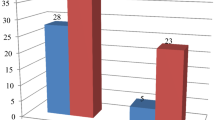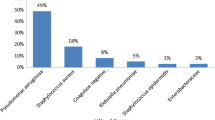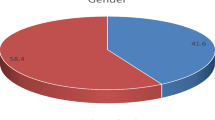Abstract
Chronic suppurative otitis media is a disease with worldwide prevalence having potentially serious long term effects. It is a disease well known for its recurrence and persistence despite treatment. A study on culture and sensitivity of aural discharge collected from 40 cases of bilateral chronic suppurative otitis media was done to compare the bacteriological profile of either ear. Pseudomonas aeruginosa was the major organism isolated in both ears and was sensitive to Amikacin and newer drugs like Gatifloxacin. It was concluded that the infecting organisms in case of bilateral chronic suppurative otitis media are remarkably similar. If adequate treatment is instituted early, it can go a long way in reducing the prevalence of this socially embarrassing disease.
Similar content being viewed by others
References
Gulati J, Tandon PL, Singh Waryan, Bais AS (1969) Study of bacterial flora in chronic suppurative otitis media. Ind J Otol 21:198–202
Singh N, Bhaskar R (1972) Microbiological study of otitis media. Ind J Otol 24:161
Greval RS, Ram S (1996) Bacteriological patterns of chronic suppurative otitis media in Ludhiana. Ind J Med Sci 50(6):192–195
Sharma S, Rehan HS, Goyal A, Jha AK, Upadhaya S, Mishra SC (2004) Bacteriological profile in chronic suppurative otitis media in eastern nepal. Trop Doct 34(2):102–104
Ayyagari A, Pancholi VK, Pandi SC, Goswami A, Agarwal KC, Mehra YN (1980) Chronic suppurative otitis media due to anaerobic bacteria. Fourth National Congress of Medical Microbiologists 43
Collee JG, Miles RS, Watt B (1996) Test for identification of bacteria, In: Collee JG, Fraser AG, Marimon BP, Simmon A (Eds.). Mackie and McCartney Practical Microbiology, 14th edition. Churchill Livingstone, London 2:131–149
Senturia BH, Bluestone CD, Klein JO, Lim DJ, Paradise JL (1980) Report of the adhoc committee on definitions and classifications of otitis media with effusion. Ann Otol Rhinol and Lryngol 89(68):3
Chhangani DL, Goyal OP (1976) Bacteriological study in chronic suppurative otitis media. Ind J Otol 28:41–45
Loy AH, Tan AL, Lu PK (2002) Microbiology of chronic suppurative otitis media in Singapore. Singapore Med J 43(6):296–299
Chandrasekhar MR, Krishna BVS, Patil BA (2004) A bacteriological profile of CSOM with pseudomonas aeruginosa as the prime pathogen. Ind J Otol 10:10–13
Kenna MA, Bluestone CD, Reilly JS, Lusk RP (1986) Medical management of chronic suppurative otitis media without cholesteatoma in children. Laryngoscope 96(2):146–151
Pollock M (1996) Special role pseudomonas aeruginosa in CSOM: Workshop on CSOM etiology and management. An Otorhinolaryngol 17:6
Author information
Authors and Affiliations
Corresponding author
Rights and permissions
About this article
Cite this article
Sharma, K., Aggarwal, A. & Khurana, P.M.S. Comparison of bacteriology in bilaterally discharging ears in chronic suppurative otitis media. Indian J Otolaryngol Head Neck Surg 62, 153–157 (2010). https://doi.org/10.1007/s12070-010-0021-9
Published:
Issue Date:
DOI: https://doi.org/10.1007/s12070-010-0021-9




